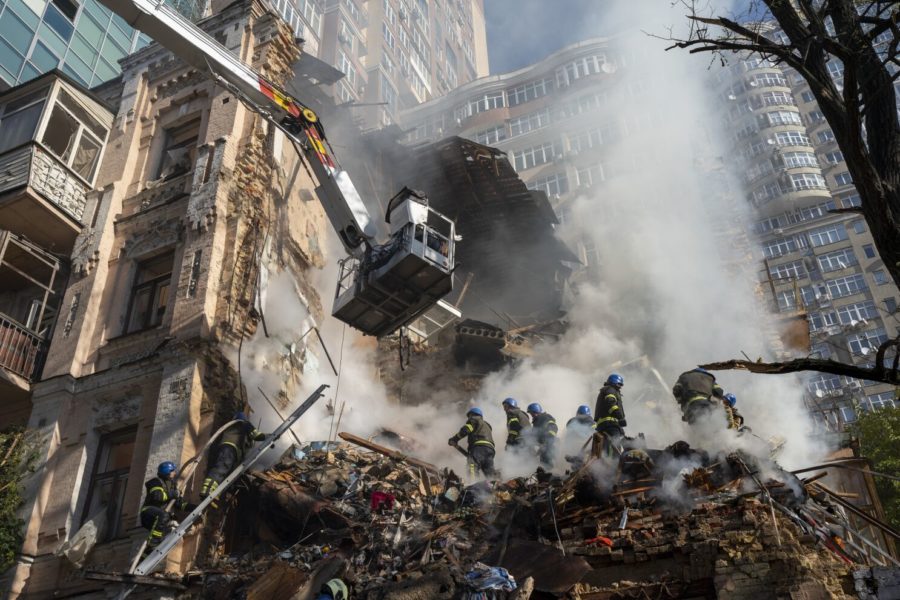Ukrainian Civilians Targeted by Russia as War Tensions Rise
October 27, 2022
Following the recent Ukrainian strike on the Kerch Bridge, which connects Russia to Crimea, and was acting as a major conduit for Russian military supplies, Putin responded by targeting civilians directly in several Ukrainian cities. On both October 10 and 11, 2022, more than 100 missiles were fired at urban centers throughout Ukraine, doing significant infrastructural damage, along with leaving 19 dead and over 100 more wounded.
About a week later, on October 17, 2022, Russia commenced strikes specifically focused on the Ukrainian capital of Kyiv. These attacks involved approximately 28 Iranian-based “kamikaze drones,” which are low-flying drones that explode when they hit their target. In the initial assault, four civilians were killed, with more injured with collisions or debris.
In terms of a larger scale impact on Ukrainian society, this new Russian offensive is having considerable influence on the Ukrainian people. Following the October 10th attacks, around 30% of Ukrainian power stations have been destroyed, resulting in “massive blackouts throughout the country,” according to Ukrainian President Volodymyr Zelensky. This included 45 energy plants, of 408 different total targets. The energy shortage prompted restrictions in some areas, such as a Chernihiv suburb’s 9 a.m. to 6 a.m. shutdown of electricity in order to conserve energy, along with issues in Zhytomyr, where hospitals began running off emergency generator power and trolleys stopped working. Clean water has also become more scarce, as tap water has started to cloud following various airstrikes, prompting long lines for bottled water.
Ukraine has already begun responding to these attacks, as, although ballistic missiles, which have been used by Russia in the past, are harder to intercept, both drones and cruise missiles, both traveling at a few hundred miles per hour, are easier to combat. Ukrainian pilots, such as one soldier, nicknamed Karaya, who shot down five drones and two missiles on a flight in an MiG-29 fighter jet, have helped in reducing the number of projectiles that actually land. Some NATO countries have also supplied Ukraine with air defense systems, which are intended to help combat the drone strikes in particular.
Russia’s decision to launch these recent strikes was interesting due to the current state of the Russian military and resources in the region. Given that Russia already has a low number of precision-guided missiles in its possession, it was a highly ineffective strategic maneuver to use solely on citizens, according to experts. Additionally, on a more global scale, attacks on civilians may have violated both international law and the laws of war, which could result in permission for NATO to officially send Ukraine defenses. This action has even prompted countries previously close to Russia, including India and China, to seek some amount of separation from the nation.
However, there are some reasons why Russia may have targeted citizens with this latest offensive, both in terms of international relations and internal politics. Since Russia failed its initial plan to rapidly take Ukraine, particularly Kyiv, some states previously dependent on Russia have started to become more independent. For instance, Kyrgyzstan denied Russia permission recently to practice military drills within the country, and Kazakhstan has issued statements rejecting the legality of Russia’s attempted annexation of Ukraine. In using strikes directly against civilians, Russia appears to be trying to strengthen its powerful image, along with reasserting that the country has a nuclear force that can be used if necessary. Within Russia itself, the loss of the Kerch bridge resulted in a major morale decrease, prompting more nationalistic members of Putin’s “selectorate,” or group of supporters, to demand a more heavy-handed approach to the situation in Ukraine.
So far, the Ukrainian people are handling the situation by conquering the fear intended to be spread by the Russian offensive. Rather than letting the potential of attacks keep them in hiding, many civilians across the country typically resume normal activities following air raids.




















































